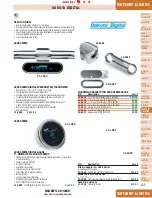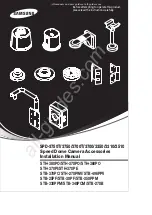
Engine Maintenance
106
5. If the fuel solenoid is not operating properly,
check the run relay (K1), the fuel solenoid pull
in relay (K6), their fuses, and the associated
circuits. If the relays, fuses and circuits are
acceptable, use steps 6 through 9 to isolate and
check the fuel solenoid.
6. Disconnect the fuel solenoid wire connector
from the main wire harness.
7. Place a jumper wire between the black wire
(CH—pin C) in the fuel solenoid connector
and a good chassis ground.
8. Test the pull-in coil by momentarily placing a
jumper between the white wire (8DP—pin B)
in the fuel solenoid connector and the positive
battery terminal. The fuel solenoid should
make a definite click when the pull-in coil is
energized and should click again when the
pull-in coil is de-energized.
NOTE: The pull-in coil will draw 35 to 45
amps so do not leave the jumper connected to
the white wire (8DP—pin B) for more than a
few seconds.
a. If the pull-in coil does not energize, check
the resistance of the pull-in coil by placing
an ohmmeter between the white wire
(8DP—pin B) and the black wire (CH—
pin C) in the fuel solenoid connector. The
resistance of the pull-in coil should be 0.2
to 0.3 ohms. If the resistance of the pull-in
coil is not in this range, replace the fuel
solenoid.
b. If the pull-in coil does energize, go to
9. Test the hold-in coil.
a. Energize the hold-in coil by placing a
jumper between the red wire (8D—pin A)
in the fuel solenoid connector and the
positive battery terminal.
b. Momentarily energize the pull-in coil by
placing a jumper between the white wire
(8DP—pin B) in the fuel solenoid
connector and the positive battery
terminal. The fuel solenoid should make a
definite click when the pull-in coil is
energized, but should not click when the
pull-in coil is de-energized.
c. De-energize the hold-in coil by removing
the jumper from the red wire (8D—pin A)
and the positive battery terminal. The fuel
solenoid should make a definite click
when the hold-in coil is de-energized.
d. If the hold-in coil does not function
properly, check the resistance of the
hold-in coil by placing an ohmmeter
between the red wire (8D—pin A) and the
black wire (CH—pin C) in the fuel
solenoid connector. The resistance of the
hold-in coil should be 24 to 29 ohms. If
the resistance of the hold-in coil is not in
this range, replace the fuel solenoid.
Fuel Solenoid Replacement
1. Disconnect the fuel solenoid wire connector
from the main wire harness and remove the
old fuel solenoid.
2. Connect the new fuel solenoid wire connector
to the main wire harness.
3. Press the
O
N
key to turn the unit on.
4. Use the Mechanics/Premium HMI Control
Panel to enter the Interface Board Test Mode.
Refer to the appropriate Microprocessor
Diagnostic Manual for specific information
about the Relay Test Mode.
5. Energize the fuel solenoid by energizing the
run relay with the Interface Board Test Mode.
NOTE: The fuel solenoid must be energized
when it is installed. If not, the plunger and
the linkage may not line up correctly and the
fuel solenoid will not function properly.
1.
Red (8D)
2.
White (8DP)
3.
Black (CH)
Figure 178: Fuel Solenoid
Connector Pin Identification
AEA633
Summary of Contents for UT-1200
Page 10: ...Table of Contents 10...
Page 20: ...Safety Precautions 20...
Page 76: ...Operating Instructions for Premium HMI Control Panel 76...
Page 88: ...Electrical Maintenance 88...
Page 98: ...Engine Maintenance 98 Figure 167 Fuel Components...
Page 142: ...Refrigeration Service Procedures 142...
Page 148: ...Clutch Maintenance 148...
Page 150: ...Structural Maintenance 150...
Page 162: ...Wiring and Schematic Diagrams Index 162...
Page 163: ...163 Schematic Diagram Page 1 of 2...
Page 164: ...164 Schematic Diagram Page 2 of 2...
Page 165: ...165 Wiring Diagram Page 1 of 5...
Page 166: ...166 Wiring Diagram Page 2 of 5...
Page 167: ...167 Wiring Diagram Page 3 of 5...
Page 168: ...168 Wiring Diagram Page 4 of 5...
Page 169: ...169 Wiring Diagram Page 5 of 5...
















































